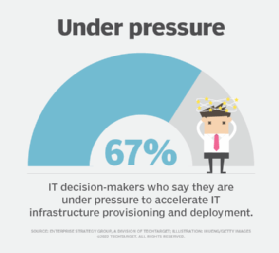Storage
- Editor's letterData storage and security make a mission-critical mix
- Cover storyThe best enterprise storage systems and products of 2021
- InfographicProactive risk mitigation should be a business priority
- FeaturePredictions for the top data storage trends of 2022
- ColumnCut down on containerized environment complexity
- Column20 years of 'Storage' magazine's Products of the Year

Getty Images
Cut down on containerized environment complexity
Containerized environments were supposed to speed up IT operations. However, too much of a good thing brings complexity challenges for organizations to overcome.
IT organizations have been given a new charter: Move even faster. Simply ensuring availability and providing reliable technology services are no longer good enough; accelerating operations has quickly risen to the top of the IT prioritization list.
According to new research from Enterprise Strategy Group (ESG), 67% of IT decision-makers said they are under pressure to accelerate IT infrastructure provisioning and deployment to support developers and line-of-business teams. That direct connection between IT operations and revenue creation is fueling acceleration demands.
For organizations that seek to achieve this faster access to technology and infrastructure resources, public cloud services have delivered transformative results. But opportunities for competitive differentiation may be diminishing. We are in an era in which digital initiatives can create a competitive advantage -- but because cloud adoption is now ubiquitous, just using the public cloud is no longer enough to get a leg up on the competition.
Not only are the benefits of using the cloud diminishing, but organizations incur increased costs as their IT environments become more disaggregated. As organizations race to scale their operations, modernize their applications and accelerate development, container adoption and usage for production applications -- both stateless and stateful -- has ballooned.
Container adoption delivers numerous benefits to the speed and quality of software development. However, as containerized environments spread across multiple public cloud providers and data center locations, the resulting complexity impedes the acceleration advantages that fueled the container adoption effort in the first place.
What is behind this increased complexity?
IT is not an easy job and it never has been. But when you combine the pressure to operate faster and scale larger with little to no increase in personnel, complexity problems arise -- especially when new technologies such as containers and Kubernetes come into play.

Whether as part of a DevOps practice or due to a desire to use public cloud infrastructure, organizations have increased their use of containers for both stateless and stateful production applications. Those activities, in turn, increase pressure on IT to speed up resource provisioning or enable developers to self-provision resources to keep pace with development activities. The increased portability of containerized applications leads to application environments more likely to span multiple data centers and public cloud environments. This situation tends to result in the following side effects that create challenges for the business and its IT organization.
- As IT teams quicken and offload the process of allocating resources to developers, they make less of an effort to ensure that those resources meet application needs. This often leads organizations to err on the side of overprovisioning, which increases cost overhead.
- The increased portability of containerized environments leads to even more locations to manage, more public cloud environments to understand and more internal teams to coordinate.
- As IT consumes resources based on usage levels across multiple public cloud environments, tracking the cost of those resources can quickly become daunting. For example, ESG found that 63% of organizations said a lack of visibility into public cloud spending hinders their IT planning.
So, even as organizations work to accelerate operations, the result is often increased complexity that causes inefficiencies and costs to rise. Those costs, while always important to control, can become a significant burden to fast-growing digital organizations. The result: Increased cost inefficiency related to usage-based services steals budget from new initiatives, ultimately slowing innovation.
How do you address these challenges?
Hire more people. Container experts are hard to find, and often even harder to retain. There is also the opportunity cost to consider. As much as possible, internal personnel should focus on developing and creating business value via new innovations and not infrastructure optimization. Avoid this option.
Outsource the complexity problem. Developing a modern container practice may be new for you, but it isn't new for everyone. Use experts who have experience working with containers. One interesting option is Taos, an IBM company and a leader in multi-cloud and DevOps services. With its Application Modernization Advisory Service, Taos tailors its guidance to the specific needs of your organization. Taos helps to increase the adoption of container-based workloads while reducing risk, helping to replatform applications through containerized environments and rearchitecting monolithic applications into a microservices architecture.
Use smarter, AI-based insights. Optimizing infrastructure using traditional processes often relies too heavily on the knowledge of a select few in the organization. Tools can offer better insight into application behavior, but figuring out the next steps is often more guesswork than data-driven process. That's why some firms are looking to integrate AI into the process. For example, StormForge is a cloud-based offering that uses machine learning and integrated performance testing to recommend optimizations for Kubernetes application deployments. As part of its process, StormForge conducts iterative experiments to help organizations understand and visualize the tradeoffs between infrastructure decisions and multiple metrics -- such as performance, availability, time and cost -- so organizations can make the best choices for their business needs.
In the digital era of business, success depends on accelerating IT operations and application development, optimizing infrastructure resources and focusing as many resources as possible on net-new innovation. Too many companies waste valuable budget dollars by not properly optimizing the environment as their container usage increases. Other companies waste too many resources trying to optimize the environment with existing tools. Use outside intelligence, whether that help comes in the form of services or better AI-powered tools.
ESG is a division of TechTarget.


























